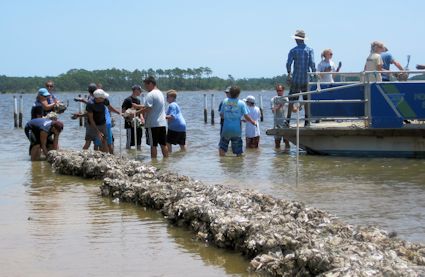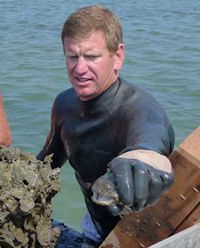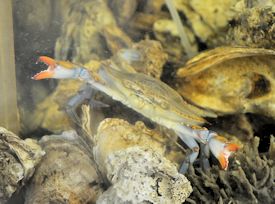 Volunteers help the N.C. Coastal Federation build an oyster reef in the White Oak River. Researchers are beginning to understand the ecological value of these new reefs, |
MOREHEAD CITY — When he began planning his research project to “listen” to fish, Joel Fodrie thought that the work would help determine the economic and biological value of restored marine habitats, especially oyster reefs.
A year or so into the project, Fodrie and his team of researchers at the UNC Institute of Marine Sciences in Morehead City have been tracking red drum, sheepshead and black drum on oyster reefs in the New River in Onslow County and the North River in Carteret County. They’re learning a lot about that primary goal, although it’s a bit too early for conclusive results. But they’re also discovering some surprising things that may change the way we view the ways we manage fish stocks.
Supporter Spotlight
For example, individual fish seem much more independent than has been thought. Although he hesitates to be too anthropomorphic, it’s almost like they have personality.
“Some are clearly more ‘local’ than others; they stay in one general location almost all the time,” he said recently. “Others are wanderers; they go off looking for something, driven by something we don’t know about or maybe don’t understand.”
As a result, he said, it appears that the common term “fish stock” might be more complex than has been thought. And that understanding may, at least to some degree, eventually upset the applecart of that aspect of fisheries management.
The research also is showing that while restored or created oyster reefs do attract large numbers of fish, what might be more important than just building the reef is its proximity to other types of habitat, especially sea grass beds. The best approach to building reefs might be to think of them not as merely stand-alone gathering points, but as integral parts in the larger system.
“We’re pretty excited about what we’re finding out,” Fodrie said. “We have a long way to go; we’re going to continue into the summer of 2014. But we are getting some very interesting results.”
Supporter Spotlight
 Joel Fodrie set out to learn the economic and ecological value of restored marine habitats. Photo: UNC |
Fodrie, an assistant professor of coastal biological oceanography at the institute, began this project knowing that North Carolina has lost at least 90 percent of its oyster reef habitat in the past 150 years or so.
Combined with the onset of parasitic diseases, the habitat loss crashed what was once a huge commercial oyster fishery. In recent years, the state Division of Marine Fisheries and nonprofit groups like the N.C. Coastal Federation have spent a lot of time and money building new reefs, both to bring back the oyster population and to serve as habitat for fish.
Although proponents of these efforts believe they have been successful – and anecdotal evidence supports those beliefs – it’s hard to know for sure.
“With trees, you can go out and mark them and go back the next year and measure them and see how much they’ve grown, how many more leaves they have,” Fodrie said. “If they’re dead, you can see that. But fish are invisible to us much of the time.
“What we wanted to do is come up with a way to say, if you restore X amount of reef, you can expect to see X number of fish.”
If you tag a fish in the traditional manner – a visible tag – you might never see it again, and you won’t really know why. And even if you do see it, or if someone catches it, you don’t know where it’s been and what it’s done between tagging and sightings.
Fodrie wanted to figure out a way around that problem. And the best way, he and others decided, was to take advantage of recent advances in acoustic telemetry. Essentially, they proposed that the N.C. Division of Marine Fisheries and North Carolina Sea Grant help fund a project to put acoustic broadcasting tags inside fish and position listening stations in the waters.
In the funding requests to the agencies, Fodrie noted that hundreds of thousands of dollars are spent in N.C. coastal waters each year to create or enhance reefs to help maintain fishing for Eastern oysters, which has a commercial value of about $2 million. Calculating the costs and benefits of these restoration efforts should include the economic value of the oysters harvested from these reefs and the reefs’ ecological benefits, such as improved water quality, stabilized shorelines and enhanced habitat for fish and invertebrates.
 A blue crab defends its ground on a restored oyster reef in the Chesapeake Bay. Photo: Chesapeake Bat Foundation |
“Certainly, understanding how oyster habitat enhancement affects the production of other recreationally/commercially important species could significantly alter the perceived (and realized) ecological/economic benefits or costs associated with these enhancement efforts,” Fodrie wrote in the grant proposals.
When the funding came through and the fish had been caught, researchers made small incisions in the bellies and inserted transmitting tags. They also attached visible tags to the fish so that fishermen who catch them would know they were part of an experiment. After a suitable observation period to make sure there were no adverse effects – and there weren’t – the fish were released.
Red drum and sheepshead were chosen because both are ecologically valued species, and because red drum – the official state saltwater fish – are very valuable economically. The fish has been one of three targeted, unsuccessfully so far, for game fish status, which would make them off-limits to commercial fishermen.
In his funding request, Fodrie noted that the two species are similar in some ways: “Both go to sea grass and marsh creek nurseries following seasonal spawning events outside estuaries, and both grow relatively quickly, reaching maturity within two (males) to four (females) years.”
The state Division of Marine Fisheries has long had a red drum tagging program, but Fodrie said those data are not adept at detecting “fine-scale habitat utilization patterns,” as the acoustic telemetry can do. “As habitat restoration becomes a more important management tool for maintaining coastal ecosystem function, studies are needed to determine how larger sub-adult and adult fishes benefit from these conservation efforts,” he wrote.
As a result, while the primary purpose of the study was to come up with a way to “value” habitat restoration, a big benefit also would be the knowledge gained about the species. Fodrie said.
Acoustic tagging, he explained, isn’t new, but aspects of the way it’s being applied are novel. Perhaps the most interesting part of the effort is that each transmitter sends out not just a signal, but a unique ping, and those pings are emitted at varying times, depending on how they’re set up. Using triangulation from the listening stations, the downloaded data shows where the fish are, just as GPS shows you where you are while you’re driving around on a wandering vacation.
“Basically, we know whether we’re listening to Abraham or Peter or Bobby,” Fodrie said.
“What we’re seeing, so far, is that fish do spend a lot of time near these (reef) sites. But what is most interesting is how individualized this use appears to be. Some spend more time there than others,” he said. “Some might spend no time there. Others spend most of their time, at least at particular times, there. It’s a subtlety we often try to blur. We tend to look for averages.”
 Oyster reefs used to build so-called living shorelines like this one in Stump Sound may have the gaps that foraging fish seek. |
But averages, of course, can be deceiving. It turns out that while the “average” red drum might spend 50 percent of his time at a given point, some of those fish might spend virtually no time there while others might spend nearly all their time there. The average might hold, but there’s tremendous variation from fish to fish, contrary to the prevailing view that fish within a stock behave the same.
“In general, though, what you find is that in the summer, many of the red drum spend a lot of time at these (reef) sites,” Fordrie said, “and then in late fall, they begin spending more time in the ‘grass meadows.’
“This makes it a little hard, still, to put a value on the reefs. But it indicates that we probably need to think more about how these habitats are spatially connected and focus more on multi-habitat restoration.”
There also appear to be differences in the effectiveness of reefs in different locations. While reefs in mudflats might be the prototypical “pretty” oyster reefs, the “ugly” reefs in salt marshes seem to be more effective as fish habitat.
“That makes some sense, if you think about it,” Fodrie said. “If I’m a fish, do I want to try to get a crab or a worm from a reef that is really hard and doesn’t have many gaps in it, like the ‘pretty’ ones in the mudflats? Or, do I want to try at a reef where there are ‘soft spots,’ gaps, between the patches? That’s what I’d do if I were a fish.”
This is also seems to be a positive statement in another long-running debate: the value of so called- “living shorelines,” which are low walls or sills built, often using oyster shells and planted sea grass, to prevent or at least slow erosion of estuarine shorelines. The N.C. Coastal Federation and, to a lesser degree state agencies, have in recent years been pushing living shorelines as far preferable to sea walls. But some have doubted the ecological value of the sills. These clearly have those soft gaps of which Fodrie spoke.
“Living shorelines do appear to have the conditions that encourage fish to forage there,” he said. “Our study was not designed to measure that, but it’s a reasonable deduction from what we are seeing.”
The majority of the funding for the project has come from fees anglers pay for the state’s saltwater recreational fishing license.







